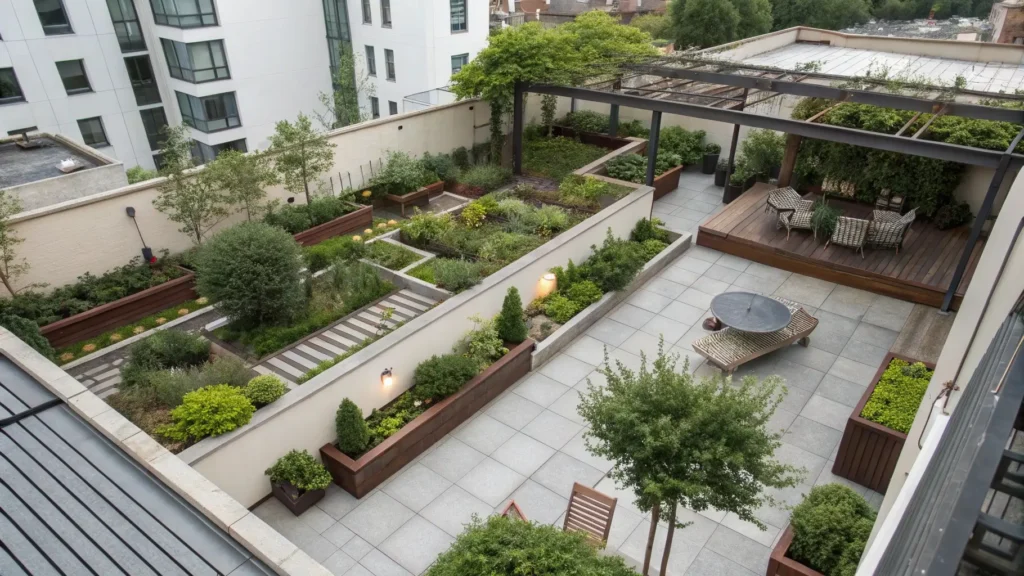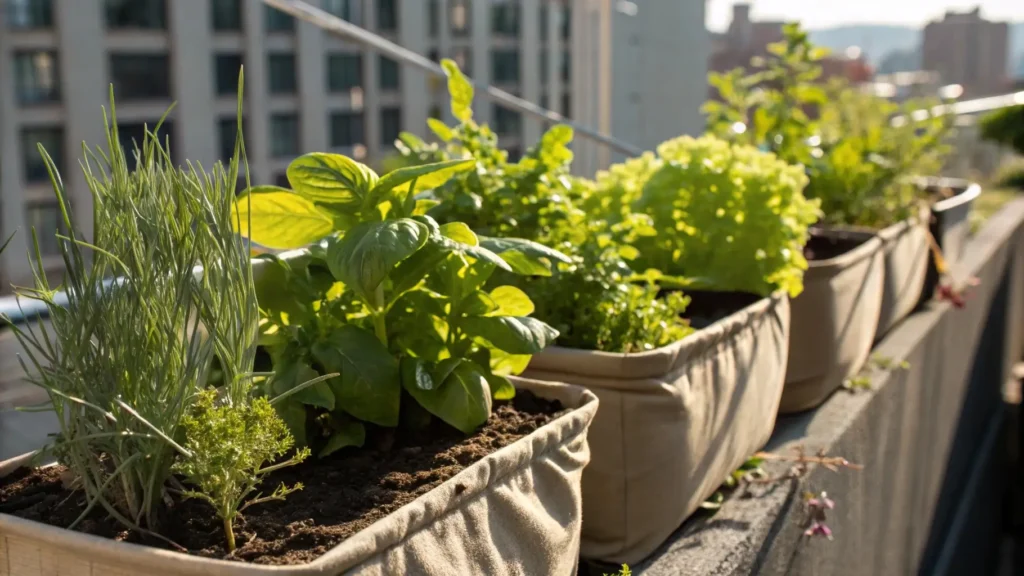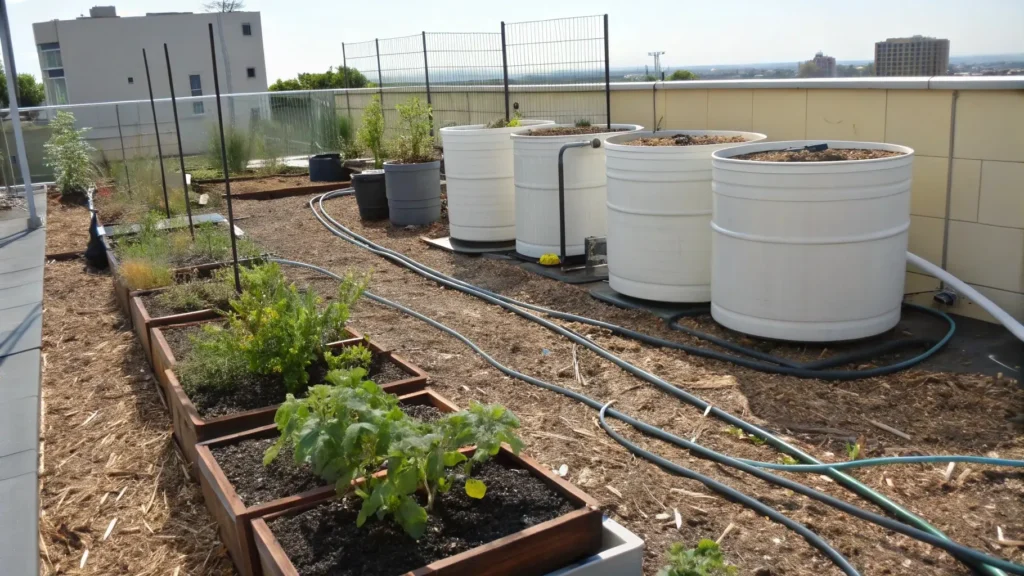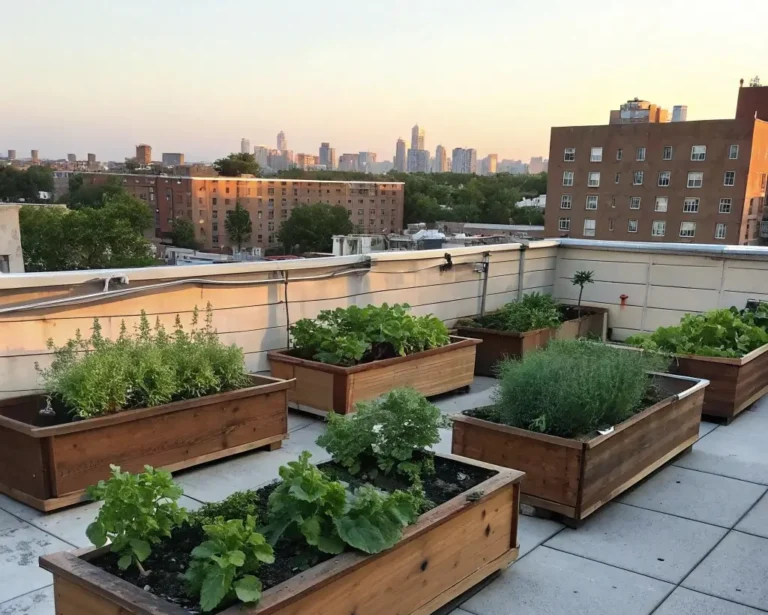Got a flat garage roof just sitting there, collecting sun and doing absolutely nothing?
You’re not alone.
For many urban and suburban homeowners, the garage roof is an overlooked patch of potential. It might not look like much now — a blank slab of concrete or tar — but with a little planning, it can become your personal rooftop oasis. Think herbs, veggies, flowers, even a cozy chair and a morning coffee spot.
A garage roof garden isn’t just a clever use of space. It’s also:
- A way to grow fresh food close to home
- An eco-friendly way to insulate your garage and cut down on energy bills.
- A surprising value booster for your property
And no — you don’t need a background in landscaping or a team of contractors to make it happen. What you do need is a solid structure, a smart plan, and a few container-friendly plants that can handle sun, wind, and the occasional dry spell.
In this guide, we’ll walk you through exactly how to turn that unused rooftop into something green, useful, and genuinely enjoyable. Let’s get into it.
Table of Contents
Can You Actually Build a Garden on a Garage Roof?
Short answer? Yes — but not without checking a few key things first.
Not All Flat Roofs Are Created Equal
Just because your garage roof is flat doesn’t mean it’s ready to support a rooftop garden. Weight is a big deal here. Between the containers, soil, water, and plants themselves, your setup can easily add hundreds of extra kilos.
Before placing a single pot, make sure the structure is load-bearing enough. Not sure? Rely on real data — don’t leave it to guesswork. Your local building code may even have rules about this kind of setup, especially for older garages.
Talk to a Pro Before You Plant
This step saves you from major headaches later. A quick consult with a structural engineer or contractor can confirm whether your garage roof can safely support a garden — or if you’ll need to make reinforcements.
They’ll check for:
- Weight limits
- Waterproofing
- Drainage systems
Skipping this step could mean leaks, cracks, or worse — so it’s worth doing it right the first time.
Planning the Space Like a Pro (Without the Drama)

Once you’ve confirmed that your garage roof can handle a garden — it’s time to plan. And trust me, this part is more exciting than it sounds. A little strategy now will save you from plant chaos and puddles later.
Keep It Light and Logical
Here’s the thing: a garage roof isn’t a backyard. It needs a garden layout that’s both smart and lightweight. Start by measuring the space and sketching out a simple plan. Think about:
- Where you’ll place containers (hint: near edges for drainage)
- Which areas get the most sun
- Room for moving around, watering, or just sitting and enjoying
Stick to lightweight raised beds, grow bags, or recycled containers — anything that won’t overload the structure. And don’t cram every square inch with pots. You want airflow, flexibility, and, let’s be honest, a space that doesn’t stress you out every time you go up there.
Drainage Isn’t Optional (Unless You Like Roof Leaks)
Here’s a mistake you don’t want to make: forgetting about water drainage.
Even the best-planned garage roof garden layout can go sideways if water has nowhere to go. Make sure:
- Your containers have proper drainage holes
- You install a drainage layer under heavy pots (like gravel trays or drainage mats)
- Water naturally flows away from the building — not toward the edges or inside walls
A soggy rooftop isn’t just annoying — it can lead to structural damage. So, take the time to build a setup that drains well, dries fast, and keeps both your plants and your roof happy.
What to Grow Up There (That Won’t Die or Tip Over)

Time to enjoy the best part: picking the perfect plants to grow in your garden. Not every plant is cut out for rooftop life, especially on a sunbaked garage with wind that doesn’t quit. But with the right picks, you can grow more than you think.
Pick Plants That Can Handle the Heat (and the Breeze)
Your garage roof gets full sun and plenty of airflow — great for some crops, brutal for others. Focus on sun-loving, wind-tolerant plants that don’t mind being in containers.
Top rooftop-friendly choices:
- Herbs: rosemary, thyme, oregano — low fuss, high flavor
- Leafy greens: arugula, lettuce, kale — fast growers, shallow roots
- Dwarf veggies: cherry tomatoes, bush beans, peppers — compact and productive
- Strawberries or dwarf berries: sweet bonus if you’ve got good light and drainage
The bonus? These plants do great in raised beds, grow bags, or deep pots — all perfect for your garage roof garden setup.
Skip the Divas (They’ll Just Break Your Heart)
Avoid plants that:
- Need constant watering
- Grow tall and floppy
- Hate wind or intense sun
Think corn, full-size pumpkins, cucumbers, or anything with heavy fruit or sprawling vines. They’ll take over your space, stress your structure, or just fall over when the wind kicks up.
The goal isn’t to grow everything — it’s to grow smart. Start with compact, manageable crops that suit the conditions up top. You’ll have a productive space without the drama.
Setup Essentials You’ll Thank Yourself For Later
Let’s be honest — hauling plants onto a garage roof is already a win. But a few smart choices in your setup can save you from heat stress, dead plants, and endless watering trips.
Use Containers That Won’t Turn Into Mini Ovens
Your garage roof gets direct sun, and some materials absorb heat like they’re trying to cook your plants.
Stick to:
- Choose light-colored fabric or plastic pots to reflect heat and keep plant roots cooler in hot weather.
- Grow bags — breathable, flexible, and surprisingly sturdy
- Opt for raised garden beds crafted from lightweight wood or recycled plastic for easy setup and durability.
Steer clear of dark metal containers—they absorb heat quickly and can overheat plant roots from the sides. And always, always check that everything has proper drainage holes.
Make Watering Easy on Yourself
Unless you enjoy carrying sloshing watering cans up a ladder three times a week (no judgment), set up a watering system that works for you.
Best options:
- A long hose connected from ground level
- Drip irrigation if you’ve got a more permanent setup
- Self-watering containers for low-maintenance days
Whatever method you choose, keep it simple. The more friction you remove, the more likely you are to stick with it — and the healthier your rooftop garden will be.
Maintenance Without the Hassle

Once your rooftop garden is up and growing, the key is keeping it alive without turning it into a second job. The roof brings extra sun, wind, and heat — but with a few smart habits, your plants will thrive without the drama.
Protect Your Plants from Wind and Sun Overload
Garage roofs catch everything — sun, gusts, heatwaves. You’ll need a little protection up there.
Try this:
- Mesh screens or lattice panels to act as windbreaks
- Shade cloth for sensitive plants during peak summer
Even placing taller plants strategically can create a natural shield for the more delicate ones. Think of your layout like a tiny wind-buffered ecosystem.
Keep Things Low Maintenance from the Start
If your goal is peaceful green space — not a second full-time job — simplify early.
Here’s how:
- Group plants with similar water needs
- Use mulch (like straw or bark) to retain moisture and reduce watering
- Stick to reliable growers instead of chasing novelty
The best rooftop garden maintenance is the kind you barely notice. A few minutes a day to check the soil, trim a leaf, enjoy the view — that’s the dream.
Conclusion – Your Rooftop Garden Starts Here
You don’t need a backyard or a fancy rooftop terrace to create something green and alive. That flat garage roof? It’s already halfway there.
With the right structure, a smart plan, and a few heat-hardy plants, you can turn that forgotten space into a garden you’ll actually want to spend time in. Whether you’re growing herbs for the kitchen, cherry tomatoes for weekend salads, or just building yourself a quiet retreat above the chaos — it all starts with one container.
Urban gardening is about maximizing small spaces and using every inch wisely. So if your garage roof is sitting there, soaking up the sun, maybe it’s time to give it a little purpose.
Go step by step. Start small. And watch that slab of concrete turn into something worth climbing the ladder for.
FAQ :
Is it possible to create a garden on top of my garage?
Yes — as long as the structure can support the weight. Before you start, have your garage roof checked by a contractor or structural engineer. A safe, load-bearing surface is essential for rooftop gardening.
What kind of plants grow best on a garage roof?
Stick to sun- and wind-tolerant plants like herbs (rosemary, mint, thyme), leafy greens, cherry tomatoes, and dwarf peppers. These do well in containers and don’t need deep soil or constant attention.
How do I stop water from pooling or leaking into the garage?
Good drainage is key. Use containers with drainage holes, add a drainage mat under heavy pots, and make sure water flows away from the building. This prevents leaks and root rot.
Do I need special containers for a garage roof garden ?
Not necessarily. Use light-colored plastic pots, fabric grow bags, or lightweight raised beds. Avoid metal or dark-colored containers — they heat up quickly and can damage roots.
What’s the easiest way to water a garage roof garden?
If possible, connect a hose to the rooftop or install drip irrigation. For smaller setups, self-watering containers are a great low-maintenance option — no daily hauling needed.

